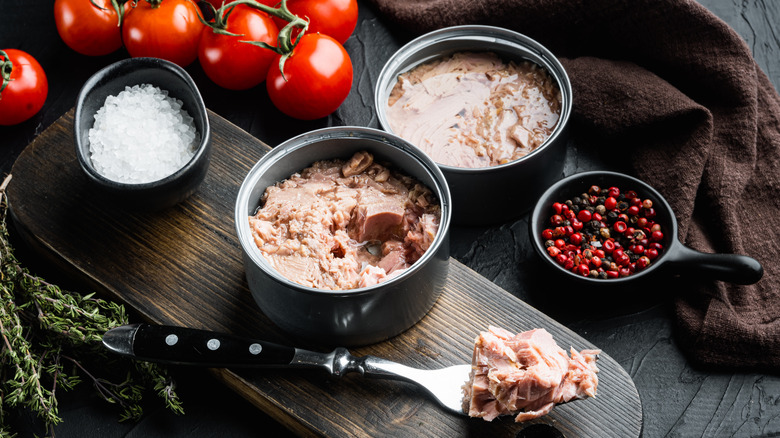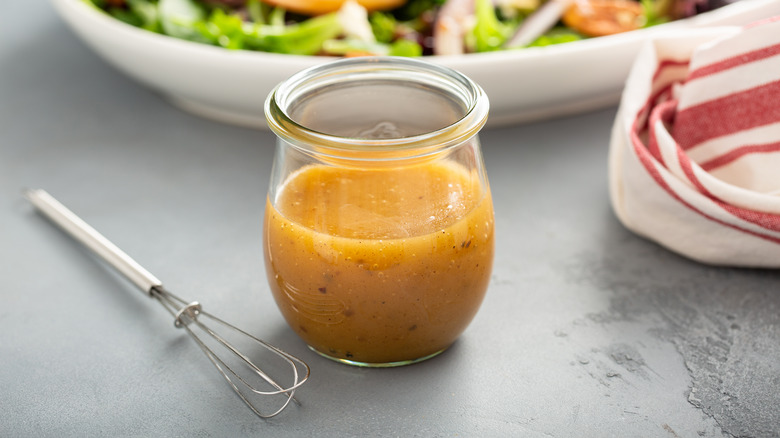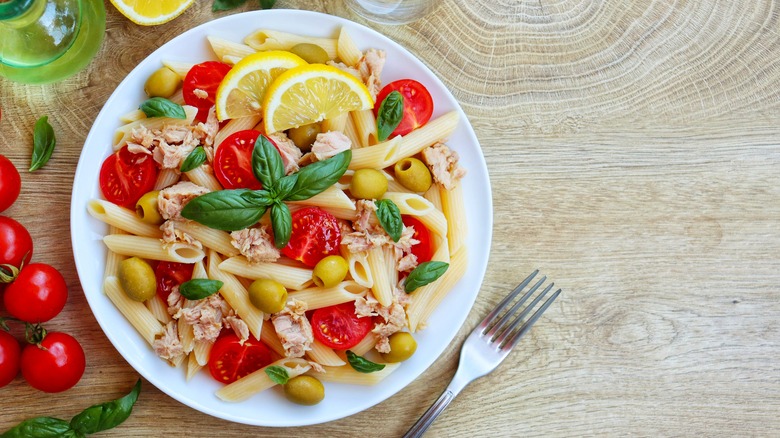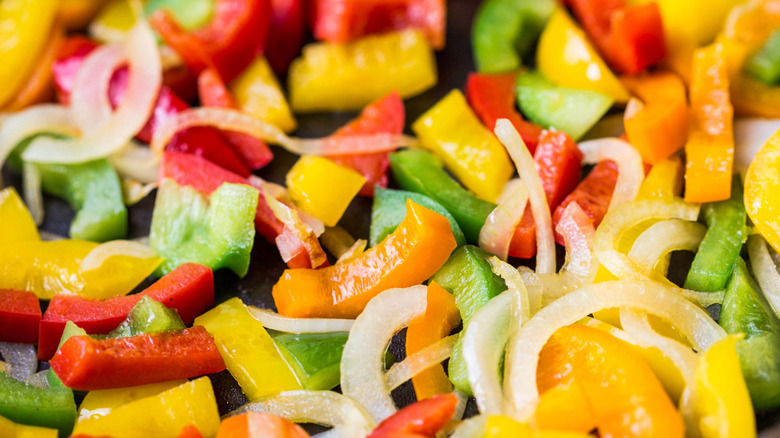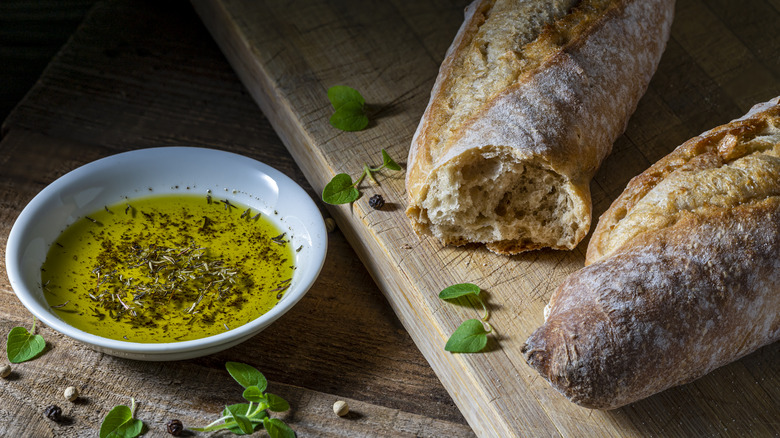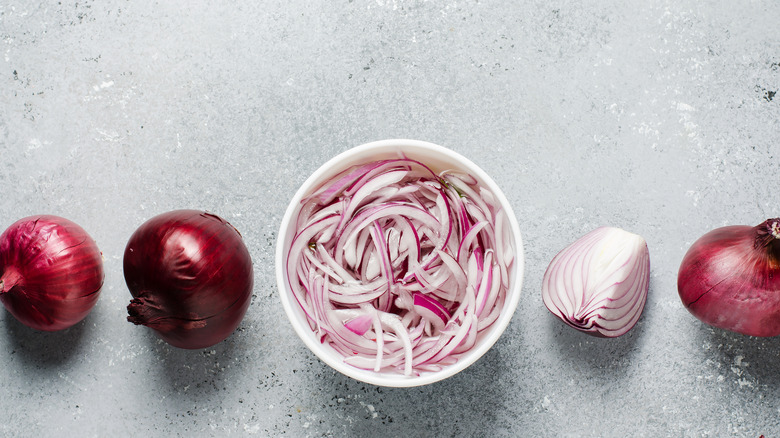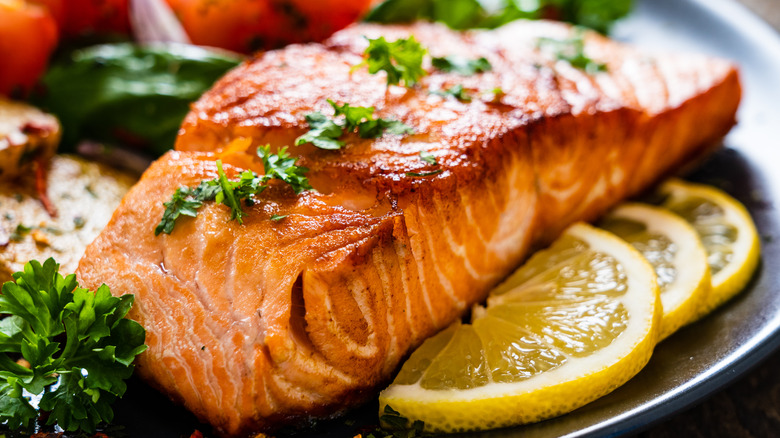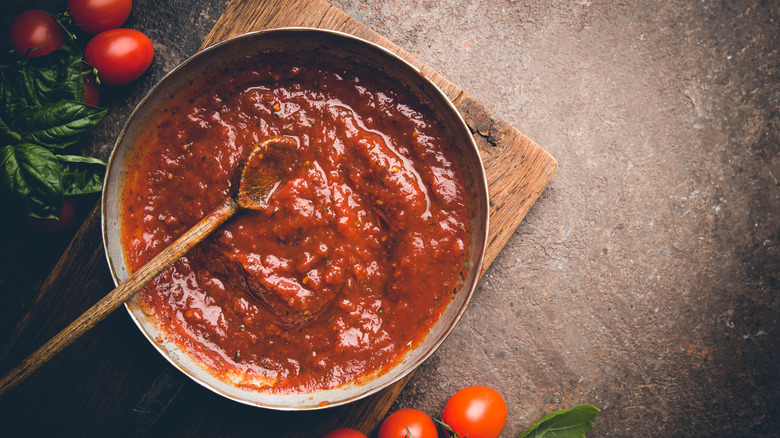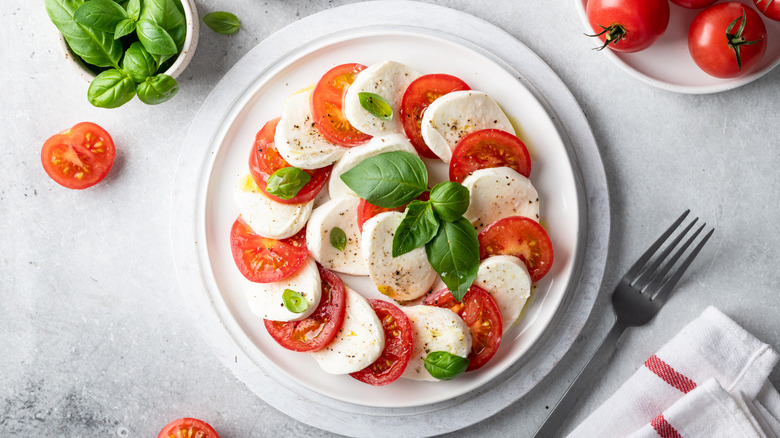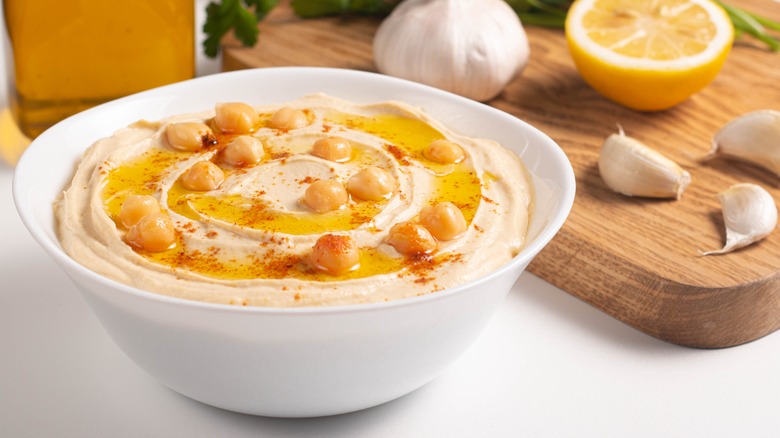12 Ways To Use Up Leftover Oil From A Can Of Tuna
It's no secret that eating healthy can be challenging, but there are a few tricks to ensure there's always a decent lunch or snack option available. One of those is to keep canned tuna fish on hand. Not only is the fish great on a sandwich or in a spread, but the oil is pretty awesome, too.
Wait, what? Doesn't the oil get drained and thrown away? If that's the case, it shouldn't be for a few reasons. When we did a deep dive into the difference between canned tuna in water and canned tuna in oil, we learned that scientific research shows some of the valuable omega-3 fatty acids in tuna don't leach into water. However, they do transfer more easily into oil. Heart-healthy omega-3 fatty acids are a big reason fish is so popular, right?
Fortunately, this seemingly unfortunate information is actually good news. According to research done by Italy's National Association of Canned Fish and the Experimental Station for the Food Preserving Industry, olive oil drained from canned tuna not only can be eaten but should be. Even if the dish that tuna was destined for in the first place calls for it to be drained — no one likes a mushy tuna sandwich, after all — there are some really good reasons to save that oil instead of dumping it down the drain, It's one more easy step on the path to reducing food waste, so let's talk about how you can use leftover oil from tuna.
Use it in dressing
It's incredibly easy to torpedo plans for a healthy meal, and one of the biggest offenders when it comes to going from healthy to not in seconds is salad. Sure, you might plan on a big salad for dinner, covered with delicious yet healthy toppings, but slather on the dressing and that can all go right out the window.
But it doesn't have to be that way. Vinaigrettes are a great option to use instead of fat- and calorie-filled creamy dressings, and they're super simple to make at home. The easiest vinaigrette is simply made with olive oil, vinegar, and seasonings — and here's where our canned tuna fish oil comes in. Oil drained from a single can is the perfect amount for making a single salad's worth of vinaigrette. No waste, plus fewer half-empty bottles crowding up the fridge is something we can all get behind. Try adding lemon juice in place of the vinegar, double down on the flavor by adding some minced anchovies and capers, and drizzle it all on some greens as a flavorful dressing.
This also works great with a Caesar dressing, which never seems to go quite far enough, right? Our Caesar salad recipe calls for olive oil-packed anchovies, which means the flavor profile for adding that leftover oil from canned tuna — and some healthy omega-3 fatty acids — is already there. Bottom line? Save your oil and dodge unhealthy salads at the same time.
Dress a pasta salad with it
It's all too easy to find that your meals are becoming the same old thing, but pasta salad is the perfect base for serving up an old favorite while keeping things fresh. It's also a great way to use up leftovers, from that last carrot in the bag to the last sprig of basil, as well as the oil drained from canned tuna.
That oil is a perfect way to dress cold pasta salad. Alone or with a handful of seasonings, it'll form a light and flavorful dressing that's ideal for those busy evenings when there are just not enough hours in the day. That doesn't mean a simple dressing is the only option, though. You can also use it as a base with sun-dried tomatoes or roasted red peppers, add some capers, or spice it up with roasted red pepper flakes.
Make sure that your pasta is cooked al dente, let it sit in the fridge for a while before serving, and keep some of the dressing aside to refresh the salad before it hits the table. For some extra color, include green beans and, when they're in season, don't forget the cherry tomatoes. With this oil, you won't regret it!
Sauté peppers and onions in tuna oil
Sautéd peppers and onions are a must to accompany Italian sausage, but they're a pretty great side dish on their own. This due is healthy, flavorful, and filling, and they're not your grandparents' boring old peppers and onions anymore. Add minced garlic, red pepper flakes, and some fresh basil, to start. And when it comes time to put your colorful peppers and onion into the skillet, use the leftover oil from that can of tuna to add an extra layer of flavor and a boost of nutritional benefits.
This also works well for sautéing other types of vegetables, too. Here's why: oil-packed tuna typically means the oil in the can is usually olive oil, sunflower oil, or soybean oil. All of those have relatively high smoke points, which means they can be heated to higher temperatures before they break down and produce smoke and off-flavors. When you're sautéing vegetables to get that perfect caramelization, you'll want to hit a temperature between 350 and 375 degrees Fahrenheit — which is right in the wheelhouse of all those flavorful oils.
Fry eggs
Fried eggs might have a reputation as a breakfast food, but they're great for a light lunch or a snack, too — and they're also a great way to use at least some of that oil you drained from a can of tuna. You don't need much to fry a few eggs, after all. Try it once and you'll find that the flavorful, nutrition-rich oil that tuna has been soaking in is a great option for boosting the flavor of an egg.
In fact, frying your eggs in olive oil is one of our top tips on ways to make this classic dish even better. There are fewer worries about high fat content getting added to your plate, as compared to when you use butter that's high in saturated fat. And let's be honest: It's the small changes that can add up to make a big difference, especially when it comes to things like heart health.
Add enough tuna oil to make sure the pan is coated, then season and fry as usual. Sprinkle the egg with salt and some fresh herbs, serve it on some avocado toast and know you've just made a healthy lunch that's going to keep you going all the way through the long afternoon hours leading up to dinner.
Make a bread dip
Some of the best evenings spent in the kitchen include deciding to make something that has a long cook time and turning a meal from a chore into an event with some music and a glass of wine. Best of all? Make some pre-dinner appetizers that you can snack on while cooking. For something simple yet delicious, put together a plate of olives, some sliced meats and cheeses, and don't forget the bruschetta — or the bread dip.
In this case, we're talking about the kind of olive oil-based bread dip that countless restaurants serve up. It's incredibly easy to make, and the versatility that comes with this one means that it's a great way to use up the oil drained from a can of tuna. It's essentially the oil with whatever seasonings strike your fancy. Go Italian with oregano, garlic, and basil, add some finely diced olives, a dash of red pepper flakes, and don't skimp on the fresh herbs. Slice the bread into bite-sized, dippable pieces, and enjoy the cooking process along with the meal.
Marinate red onions
Red onions are absolutely delicious and can be a brilliant complement to several dishes. There's a super easy way to make them even better: marinate them! After sitting in the marinade for a while, sliced or diced onions will absorb all kinds of new flavors. They also typically soften up, though not enough that they'll have an unpleasant texture.
The easiest onion marinade is a simple combination of your vinegar of choice, sea salt, and some oil. Slice the onions, layer them in a jar, add your liquid, and then let them sit. The result is brilliant on things like salads, sandwiches, and even fish tacos.
There's a bonus here, too: It's easy to make right when you're draining a can of tuna for a sandwich. Red onion is delicious on a tuna salad sandwich, and by marinating what's left of the onion, you'll keep the oil from sitting around and potentially going bad. No waste from the onion, no waste from the tuna, and a versatile, healthy, delicious topping? It's a total win.
Sauté fish
Fish is becoming more and more popular across the United States, and there are so many ways to cook and serve this protein that it can be a little overwhelming when it comes time to find what's best for your family. One of the go-to ways is a straightforward favorite: simply cooking and searing it in a pan.
Anyone who's ever tried this has probably had it go wrong at least once. Properly searing fish can feel like an art form, especially when it comes to getting it to stay in one piece and creating that wonderful seared texture. It's all too easy to go from a delicate piece of perfectly cooked fish to, "Hey, kids, we're having a pile of fish crumbles tonight!" Fortunately, there are a few tricks to getting that sear. One of those is using just a small amount of oil — like the kind that's drained from a can of tuna.
That amount of oil will be just about perfect for searing several pieces of fish. Just add to the pan and heat it. Measure it carefully, as adding too little or too much oil (and not getting it hot enough) can cause the fish to stick to the pan and fall apart. But get it right, and it's guaranteed to become a family favorite that's loaded with nutritional goodness.
Brush it on a pizza
Ordering pizza is definitely life goals on those really bad days when you just can't anymore. But here's the thing: Making your own pizza from scratch is almost deceptively easy, and there are some serious benefits to doing it yourself. With a few tricks, you can amp up your pizza game well past delivery. What's more, you can experiment with fun toppings that aren't offered at most pizza places.
One of those tricks involves brushing the raw dough with a thin coating of olive oil. That's right — here's where the leftover oil from your tuna fish comes in. While even good pizza is great, a soggy crust is enough to ruin even the tastiest sauce and the best toppings. Adding that coating of oil will help ensure that your crust is going to bake up crispy and firm. Swirl on your sauce and pile on your toppings after you brush on the oil, and you'll be shocked at the difference it makes.
Now, we're talking about leftover oil, but it's worth mentioning similarly fun, and maybe weird topping. Visit a pizza place in Germany, and you're likely to see the odd-to-American-eyes option of a tuna pizza on the menu. Feeling adventurous? Make it at home! Brush the tuna oil on the crust, top with the tuna fish, and enjoy a unique pizza with practically no waste.
Use it in red sauce
Red sauce is one of those versatile staples that can be easier to make from scratch than you think — especially if you pick a night, make a massive batch, and freeze it in portion sizes needed for a quick meal during the week. And yes, you should definitely be adding the oil from canned tuna to your red sauce.
Odd? Not at all! There's no tried-and-true, one-size-fits-all method of making red sauce, for one. And, at the end of the day, a truly great one is a balance of sweet and savory that tingles your particular taste buds. Adding tuna oil is a great way to amp up the umami flavor along with all those nutritional benefits we've been touting.
Don't have the time or desire to make your own red sauce? That's completely understandable, and you can still use this hack to elevate a store-bought jar of sauce. Just add your tuna fish oil as you're heating the sauce. It sort of counts as homemade now, right? Sure!
Drizzle tuna oil on a Caprese salad
There's nothing that says a dish has to be complicated to be tasty. Look at queso: It doesn't get any easier than Velveeta and Ro-Tel mixed together, and that's pretty much the pinnacle of party cuisine. The same is true of the Caprese salad. It's an incredibly simple dish of tomatoes, basil, and mozzarella cheese — and it's delicious.
There are a few different ways to make a Caprese salad, from the traditional slices to mixing everything in a bowl in a more salad-like manner. We found that cherry tomatoes work brilliantly for this, especially when they're about the same size as the balls of mozzarella.
That said, there are also a few different ways you can use leftover oil from a tuna fish can to accent the fresh flavors of this Italian favorite. While you can drizzle it over slices or salads for a salty, umami burst of flavor, you can also incorporate it into a tomato-based vinaigrette that can be added to the mix. Either way, you can't go wrong and this summertime classic might just get a little classier.
Replace the olive oil in your favorite hummus recipe
Hummus is another one of those foods that's easy to pick up at the store, but is still worth making at home That's especially true considering how many different varieties and options for flavors there are. (Anyone who has never tried roasted red pepper hummus needs to... like, yesterday.) A simple, straightforward hummus recipe is pretty easy and calls for only a few ingredients. Along with chickpeas and lemon, you'll also need some olive oil. And that, of course, is where the leftover oil from a tuna fish can comes in.
Using olive oil that's been soaking with tuna fish will add an interesting, salty dimension to the flavor profile of hummus, although it's worth tasting as you go along to keep things from getting too salty.
For an even stronger flavor, you can also drizzle some of the oil on top of the hummus before serving. Not only is it a great way to get an extra kick of flavor scooped onto pita chips or veggies, but it also looks impressive. Serve this at a party, and no one will be able to guess how easy it really was to whip together.
Add an extra dimension to soups
The oil left over from a can of tuna can be used in almost any soup that calls for a dash of olive oil. In the same way that it adds umami flavor to your favorite red sauce, it can do the same for soups.
Although umami and salty might seem to be the same thing at a glance, they're not. Salty is, well, salty, while umami can be thought of as essentially the taste of savory. It also acts to bring flavors together — and that's what canned tuna fish oil will help to do with your favorite soups.
Swapping out plain olive oil for olive oil that's been soaking with tuna fish can bring a new, surprising dimension to soup classics. It's also brilliant in creamy soups, like cream of asparagus or cream of mushroom — and that latter variation, by extension, can elevate other dishes. Making a casserole with cream of mushroom soup? Add some of that tuna fish oil while you're at it. This will also work to balance the sweetness of a carrot or butternut squash soup, accent flavors in a cauliflower and potato soup, and when you sauté the vegetables destined for soup in oil from your tuna first? Delicious, nutritious, and no waste.
